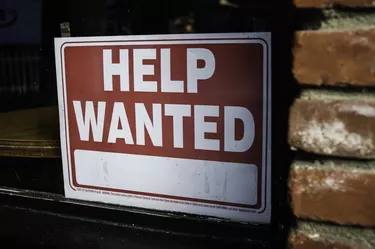
Business closures during the pandemic rocked the U.S. labor market by forcing an estimated 30 million American workers into unemployment. The Federal Reserve (Fed) estimates nearly 200,000 businesses closed due to the pandemic. In 2021, job openings steadily increased, and the unemployment rate decreased – does that mean the labor shortage is finally over?
An Improved Labor Shortage Continues
Video of the Day
The U.S. Bureau of Labor Statistics (BLS) Job Openings and Labor Turnover Survey (JOLTS) publishes employment-related data each month. While the overall outlook has been improving over the past year, America's shortage of workers isn't over.
Video of the Day
In April 2020, the labor force participation rate, which represents the number of working-age Americans actively seeking work, declined to 60.2 percent. It had hovered around 63 percent from 2014 to 2019. Since the pandemic the participation rate has been inching its way up, reaching 62.4 percent in March 2022.
Reasons for slow worker return include stimulus checks and unemployment benefits enacted by the Trump and Biden administrations and the Great Resignation or the Great Reshuffle. As workers reevaluated their satisfaction and happiness in their pre-COVID working conditions, they left the workforce altogether or set their sights on a new career path.
Current BLS reports show that the number of long-term unemployed is 20 percent higher than in February 2020. Another 373,000 discouraged workers believe that no job openings are available for them. Some 2.5 million workers report being unable to work due to their employer being closed or having limited work available, and 874,000 workers report being unable to seek work due to the pandemic.
Meanwhile, there are 11.3 million jobs currently open, leaving some economists to theorize that America's pool of workers may be shrinking in the long term.
Consider also: Can the Pandemic Make the Workplace Better for Women?
Early Retirement and the Labor Force
Other economists predict COVID's impact on the labor force participation rate will continue as older workers take early retirement. Last year, actual retirees exceeded expectations by more than 2.5 million. Before the pandemic, adults age 55 were the only age group increasing their labor force participation, reports Pew Research.
The BLS April Household Data survey reports many workforce levels returning to pre-pandemic levels. The prime-age worker demographic, aged 25 to 54, is moving back into the labor market, though levels still trail 2019 numbers in most states.
However, at the end of 2021, around 40 percent more parents were still unemployed, above and beyond pre-pandemic levels. Lingering childcare issues related to school-year disruptions were among the top reasons.
Consider also: COVID-19 & Early Retirement Plan Withdrawal Taxes
The U.S. Economy and Job Market
As employers faced a tight labor market with a shortage of workers for their record-high job openings, they were forced to get more competitive with their offerings to reach staffing needs. Workers did see some benefits, but not enough.
Workers in traditionally low-paying entry-level jobs like food service, retail or high-contact healthcare positions had the highest quit rates. These labor force sectors began to see higher wages, signing bonuses, and increased flexibility. Full-time workers in lower-contact sectors found increased bargaining power and opportunity for remote work.
Meanwhile, there are 11.3 million jobs currently open, leaving some economists to theorize that America's pool of workers may be shrinking in the long term.
The BLS reported wage growth of 5 percent in 2021, but that figure is facing a downturn, with wages down 0.8 percent in January. Alongside the current inflation rate of 7.9 percent, interest rates on the rise, and growing volatility due to Russia's war on Ukraine, it's clear that recent wage growth isn't keeping up with the American worker's changing world.
Consider also: Job Transitions & Your Career
The Future of Workers and Work
McKinsey Global Institute's report, The Future of Work After COVID-19, suggests that remote work, digitization and automation are resulting trends from the pandemic that may forever change the nature of work.
Coupled with consumer behavior changes and the acceleration of e-commerce, today's labor shortage may indicate that the American workplace and workers are experiencing shifts that will persist – and eventually find alignment.
- Pew Research: Working Parents Face Continued Chaos Despite Reopened Schools
- Bureau of Labor Statistics (BLS): Real Earnings Summary (March 10, 2022)
- U.S. Chamber: Understanding America's Labor Shortage
- McKinsey & Company: The Future of Work after COVID-19
- The Federal Reserve: Business Exit During the COVID-19 Pandemic
- PBS: Why Millions of Older Americans Are Retiring Early in the Wake of the Pandemic